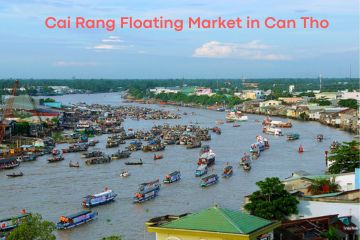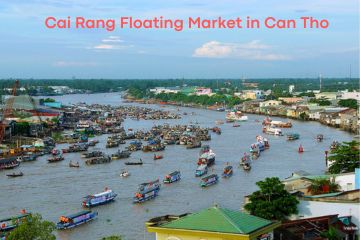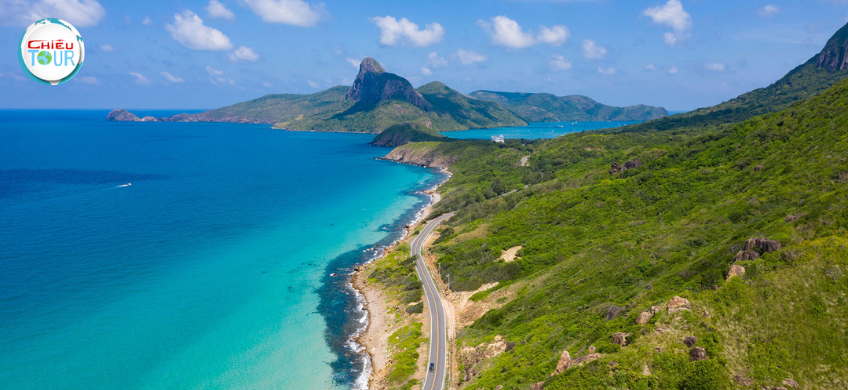
Experience visiting Cai Rang Floating Market in Can Tho
- Author: Admin
- | Hot destination
Experience visiting Cai Rang Floating Market in Can Tho
Cai Rang Floating Market offers a captivating experience that transcends mere shopping. It invites you along the waterways woven throughout the Mekong Delta, showcasing a rich cultural exchange, a legacy of trade, and an enduring connection to traditions that have flourished for generations. A visit to this market becomes more than just an excursion; it transforms into a narrative of resilience, community spirit, and the celebration of agricultural abundance.
As you glide along the rivers, the vivid display of produce evokes a sense of wonder and curiosity. Each boat tells its own story, from the skilled vendors navigating their vessels with ease to the delicious aromas wafting through the air, hinting at mouth-watering dishes waiting to be sampled. This floating market is not merely a place to purchase goods, but rather a dynamic social space where people gather, interact, and share their lives with one another.

The experience of Cai Rang Floating Market is immersive and evolving, inviting visitors to engage with the rhythms of daily life on the water. As we embark on this exploration, let’s take a closer look at the fascinating formation and history of the Cai Rang Floating Market.
The formation of Cai Rang Floating Market in Can Tho
The origins of Cai Rang Floating Market are deeply interwoven with the geography of the Mekong Delta, which is characterized by an intricate network of rivers, canals, and swamps. This unique landscape has long shaped the way communities interact, trade, and sustain themselves. The market itself began as a natural extension of local agricultural practices, allowing farmers and villagers to sell their surplus crops directly from their boats.
Over the years, the market evolved into a bustling center for trade that attracted vendors from surrounding areas. Today, Cai Rang is known as the largest floating market in the Mekong Delta, showcasing the region's agricultural richness and acting as a vital lifeline for local economies. Its formation reflects a deep-rooted relationship between the land and its inhabitants—a relationship forged over centuries of innovation and adaptation.
The history of the establishment of Cai Rang Floating Market
Cai Rang Floating Market is not simply a result of chance but the culmination of historical events that shaped the region. The market likely traces its roots back to the French colonial period when the Mekong Delta experienced significant agricultural development. As settlers cultivated rice paddies and fruit orchards, the need for efficient transportation methods became apparent.
The waterways that crisscross the delta provided the perfect solution for transporting goods, leading to the emergence of floating markets as an essential aspect of local commerce. In this context, Cai Rang blossomed into a vital trade hub, facilitating the exchange of goods among farmers, traders, and consumers.
Today, Cai Rang Floating Market continues to thrive, reflecting both the challenges and triumphs faced by its vendors. It stands as a testament to the adaptability of the local population and their commitment to preserving their traditions in the face of modernization.
The role of the market in local culture
At its core, Cai Rang Floating Market serves as a microcosm of local culture, encapsulating the essence of life along the Mekong River. Here, people don’t just come to buy and sell; they engage in a social fabric enriched by camaraderie and a sense of belonging. The market is a melting pot of interactions, where relationships are woven through shared laughter, discussions, and cultural exchanges.
The floats not only represent commerce but also embody the vibrancy of the region’s lifestyle. Early mornings are filled with the sounds of vendors shouting out their wares, the gentle lapping of water against boats, and the chatter of patrons engaging in lively conversations. It’s a symphony of life, and each note plays a part in the greater narrative of the Mekong Delta.
Furthermore, the market reflects the diversity of the region's ethnic groups, with vendors from various backgrounds contributing to the colorful tapestry of products available. From fresh tropical fruits to handmade craft items, every corner of Cai Rang teems with the richness of tradition and heritage, making it an essential destination for anyone wishing to understand the intricacies of Vietnamese culture.
The ideal time to visit Cai Rang Floating Market in Can Tho
Timing your visit to Cai Rang Floating Market can significantly enhance your experience. Factors such as climate, seasonal produce, and peak trading hours play a crucial role in determining the ideal moments to explore this extraordinary marketplace. Knowing when to go allows you to immerse yourself fully in the vibrant atmosphere and capture the essence of the market.
What season is best to visit Cai Rang Floating Market?
Experience visiting Cai Rang Floating Market in Can Tho
Nestled within the heart of the Mekong Delta, Cai Rang Floating Market in Can Tho is a mesmerizing blend of vibrant culture and traditional commerce. This extraordinary market not only serves as a hub for local farmers and residents but also offers travelers a unique glimpse into the daily lives of those who call this area home. By journeying through the winding rivers of Can Tho, visitors can experience an authentic slice of Vietnamese life where boats laden with fruits, vegetables, and various goods create a lively tapestry of color and sound. Join me as we delve deeper into this enchanting floating market, exploring its formation, historical significance, and the best times to visit.
Experience visiting Cai Rang Floating Market in Can Tho
Cai Rang Floating Market offers a captivating experience that transcends mere shopping. It invites you along the waterways woven throughout the Mekong Delta, showcasing a rich cultural exchange, a legacy of trade, and an enduring connection to traditions that have flourished for generations. A visit to this market becomes more than just an excursion; it transforms into a narrative of resilience, community spirit, and the celebration of agricultural abundance.
As you glide along the rivers, the vivid display of produce evokes a sense of wonder and curiosity. Each boat tells its own story, from the skilled vendors navigating their vessels with ease to the delicious aromas wafting through the air, hinting at mouth-watering dishes waiting to be sampled. This floating market is not merely a place to purchase goods, but rather a dynamic social space where people gather, interact, and share their lives with one another.
The experience of Cai Rang Floating Market is immersive and evolving, inviting visitors to engage with the rhythms of daily life on the water. As we embark on this exploration, let’s take a closer look at the fascinating formation and history of the Cai Rang Floating Market.
The formation of Cai Rang Floating Market in Can Tho
The origins of Cai Rang Floating Market are deeply interwoven with the geography of the Mekong Delta, which is characterized by an intricate network of rivers, canals, and swamps. This unique landscape has long shaped the way communities interact, trade, and sustain themselves. The market itself began as a natural extension of local agricultural practices, allowing farmers and villagers to sell their surplus crops directly from their boats.
Over the years, the market evolved into a bustling center for trade that attracted vendors from surrounding areas. Today, Cai Rang is known as the largest floating market in the Mekong Delta, showcasing the region's agricultural richness and acting as a vital lifeline for local economies. Its formation reflects a deep-rooted relationship between the land and its inhabitants—a relationship forged over centuries of innovation and adaptation.
The Mekong Delta experiences a tropical climate characterized by two distinct seasons: the rainy season and the dry season. Typically, the dry season, spanning from December to April, presents the most favorable conditions for visiting Cai Rang Floating Market. The skies are generally clear, and rainfall is minimal, ensuring pleasant weather for excursions along the river.
During this time, visitors can revel in the abundant harvests that define the market. The bounty of seasonal fruits—such as rambutan, durian, dragon fruit, and coconuts—delivers a visual feast for the senses and a culinary adventure for food lovers. In contrast, the rainy season, while offering lush landscapes and unique flora, may present challenges regarding accessibility and visibility.
If you’re looking to avoid the tourist rush and experience the market in its authentic form, consider visiting during the shoulder months of the dry season. Late February or early March provides an opportunity to witness the market at a quieter pace while still enjoying the vibrant displays of fresh produce.
What time of day is best to visit Cai Rang Floating Market?
While the season sets the stage, the timing of your visit within the day can elevate your experience exponentially. The early morning hours—specifically around sunrise—are considered the optimal time to explore Cai Rang Floating Market. During these hours, the market comes alive, with vendors arriving alongside the first light of dawn to set up their stalls and showcase their goods.
Arriving before the sun rises allows you to witness the magical transformation of the waterways as the sun paints the sky with hues of orange and pink. The early morning atmosphere is tranquil, yet full of anticipation, as vendors prepare their offerings and eager customers begin to trickle in. It’s in this moment that you can feel the heartbeat of the market as it awakens, revealing glimpses of daily life in its purest form.

In the late morning, however, the market starts to reach its peak activity, bustling with energy as boats maneuver through the maze of floating stalls. The aroma of steaming bowls of noodle soup, fresh fruits, and grilled delicacies fills the air, creating an irresistible invitation to sample the local cuisine. However, as the sun begins to climb higher, the intensity of the heat can become overwhelming. Hence, the early morning visits remain the most rewarding for a comfortable and enjoyable experience.
Conclusion
Cai Rang Floating Market in Can Tho is truly a gem of the Mekong Delta, offering visitors an unforgettable experience steeped in culture, history, and flavor. From understanding the market’s formation and significance to discovering the ideal times to visit, each facet reveals a rich narrative that connects past and present.
It’s not just a marketplace; it's a living testament to the resilience and adaptability of the local community, showcasing how traditions can flourish amidst modernity. Whether you're drawn by the allure of vibrant colors, the scent of fresh produce, or the warmth of human interaction, a visit to Cai Rang Floating Market promises to be a transformative experience.
So, if you’re planning your journey to Vietnam, make sure to include Cai Rang Floating Market on your itinerary. Let the sights, sounds, and flavors envelop you, and immerse yourself in the beautiful tapestry of life that unfolds upon the waters of the Mekong Delta. Your adventure awaits!
 Vietnam
Vietnam 
.png)




